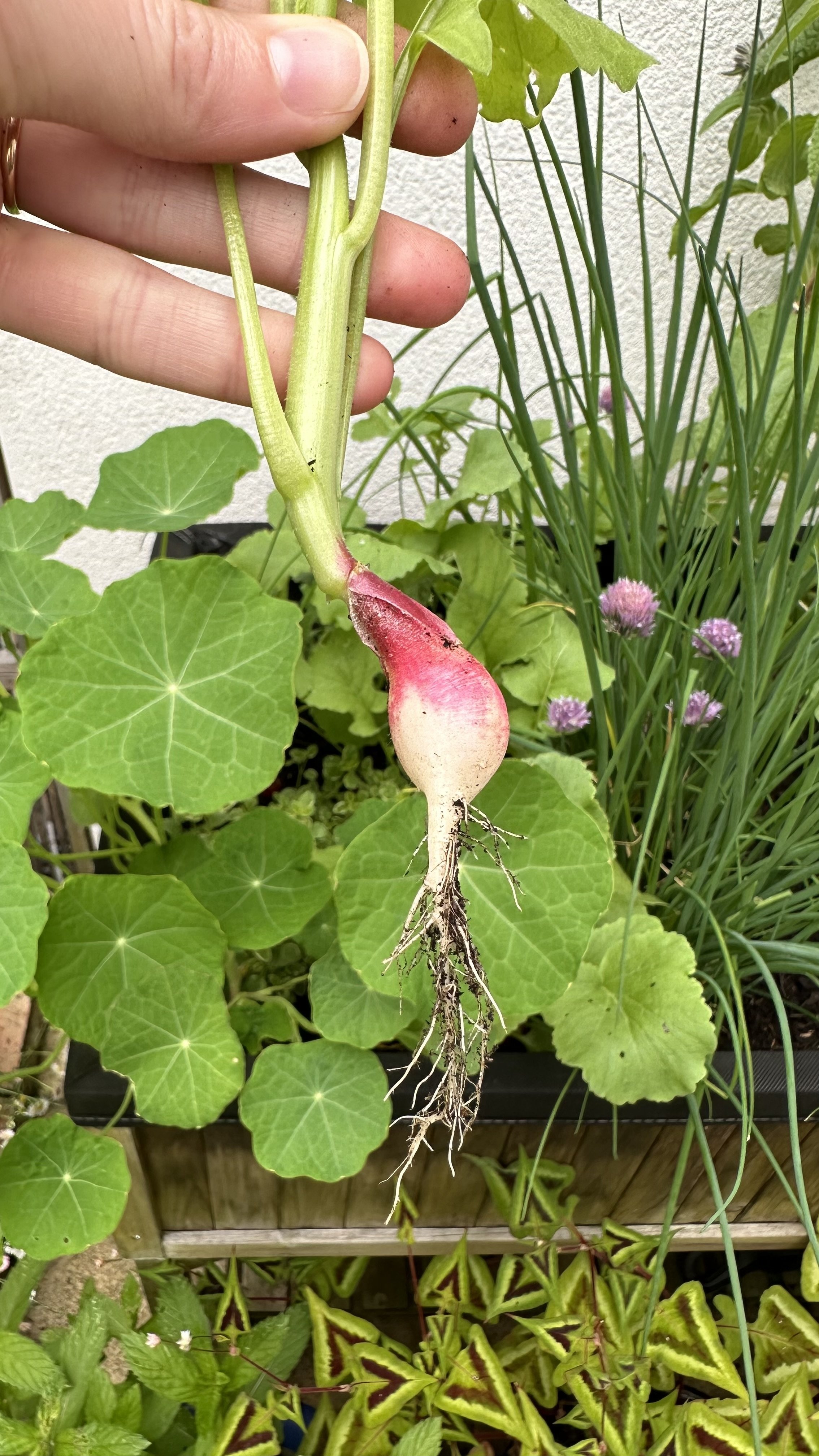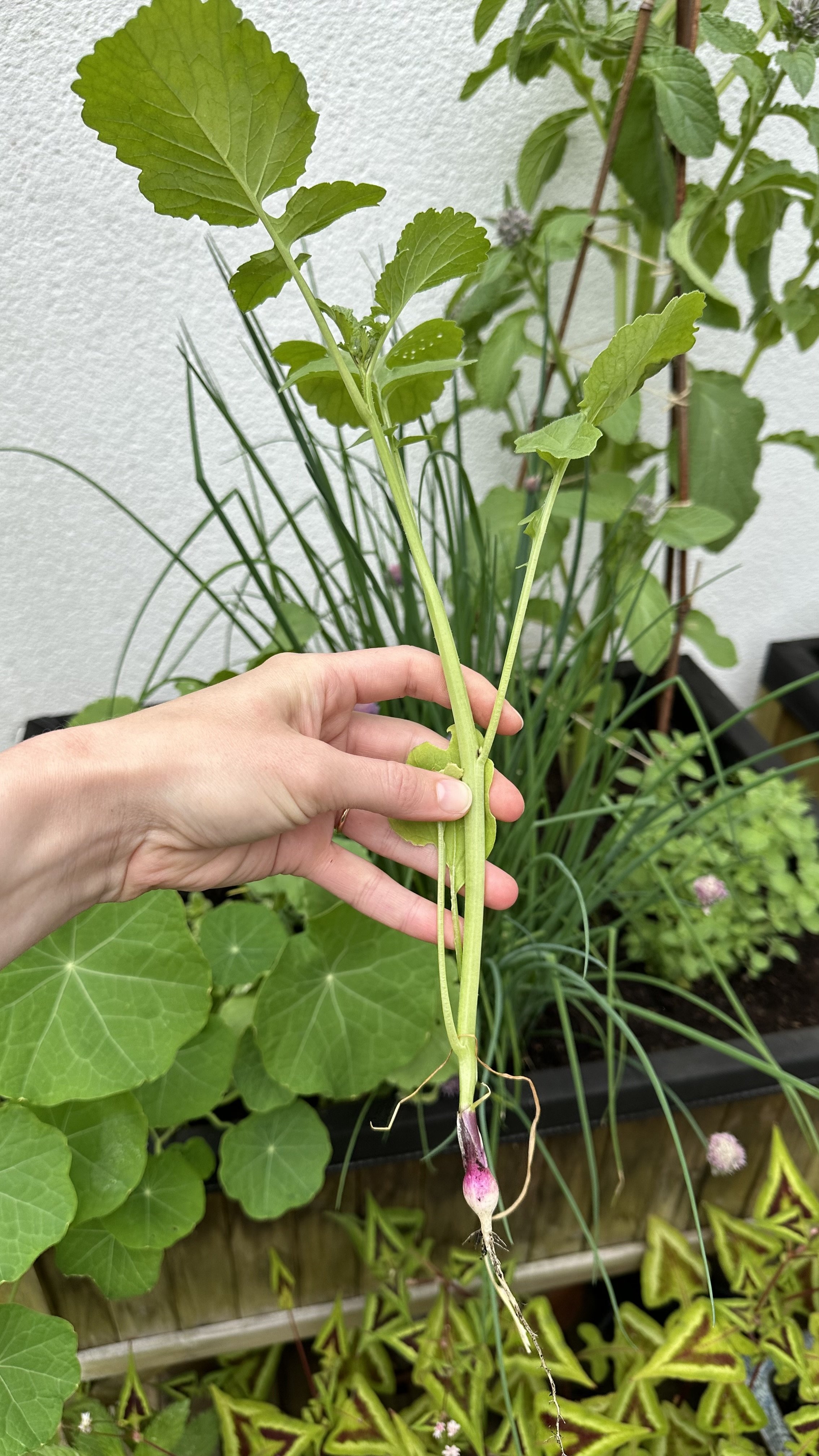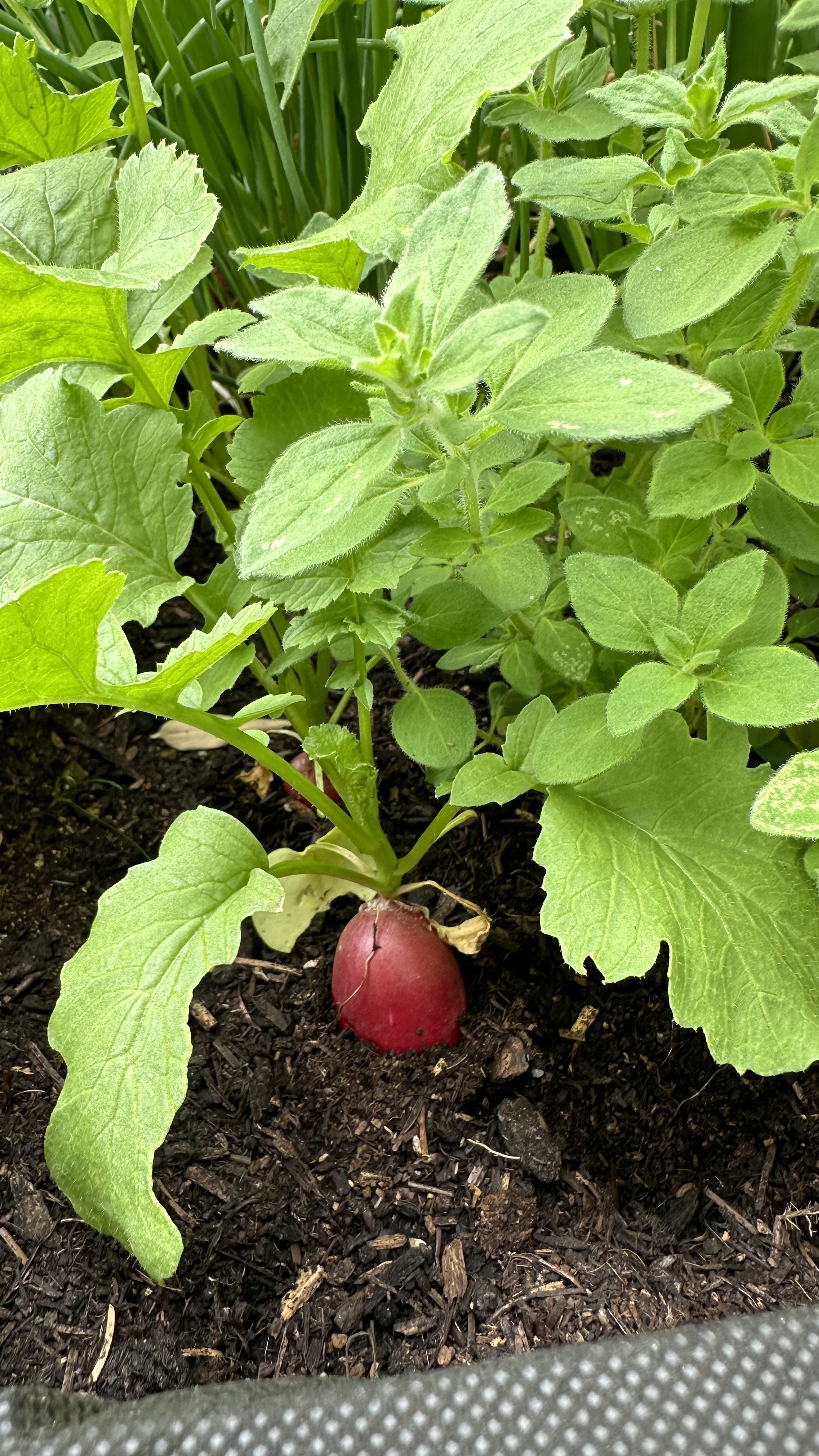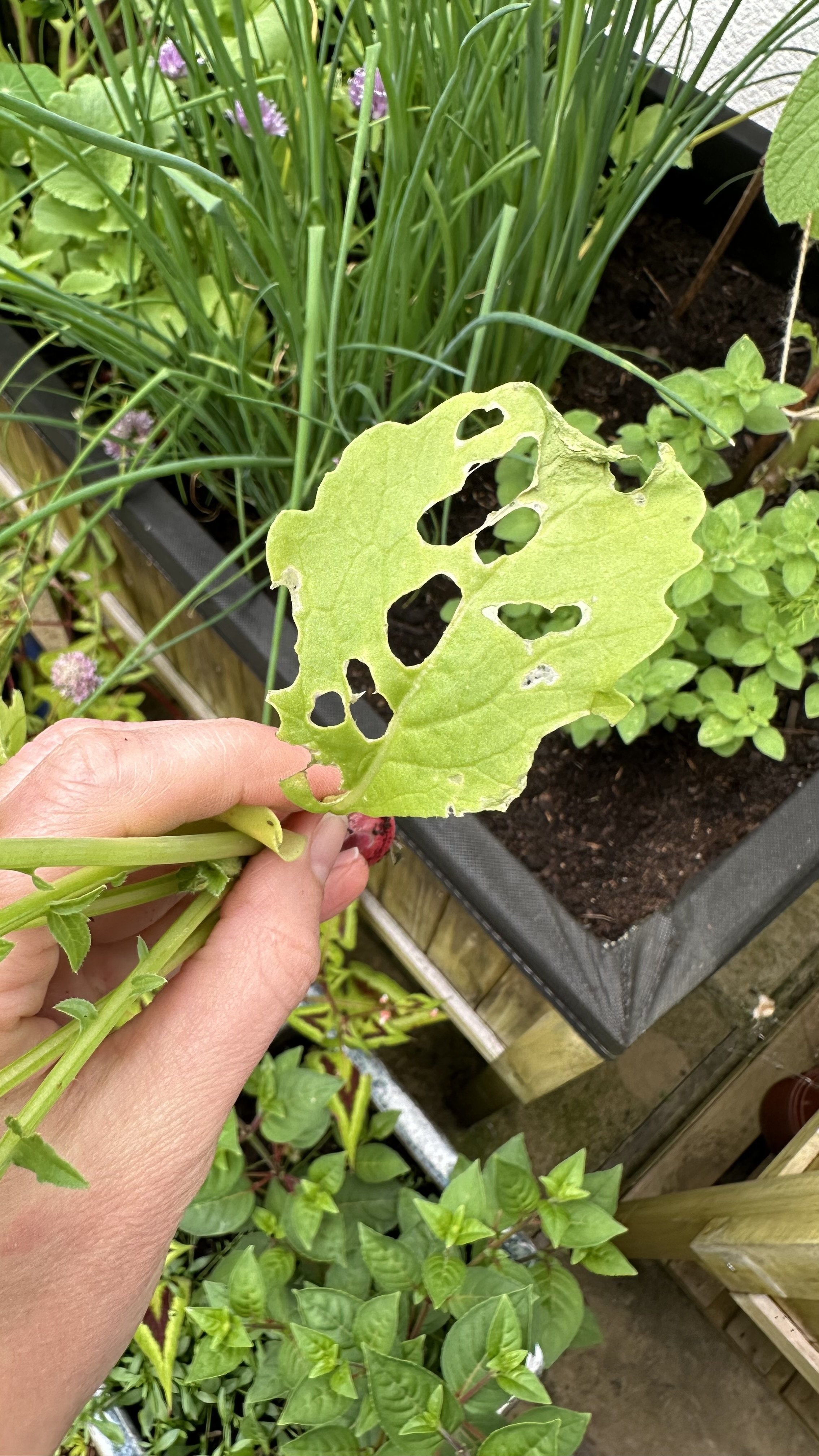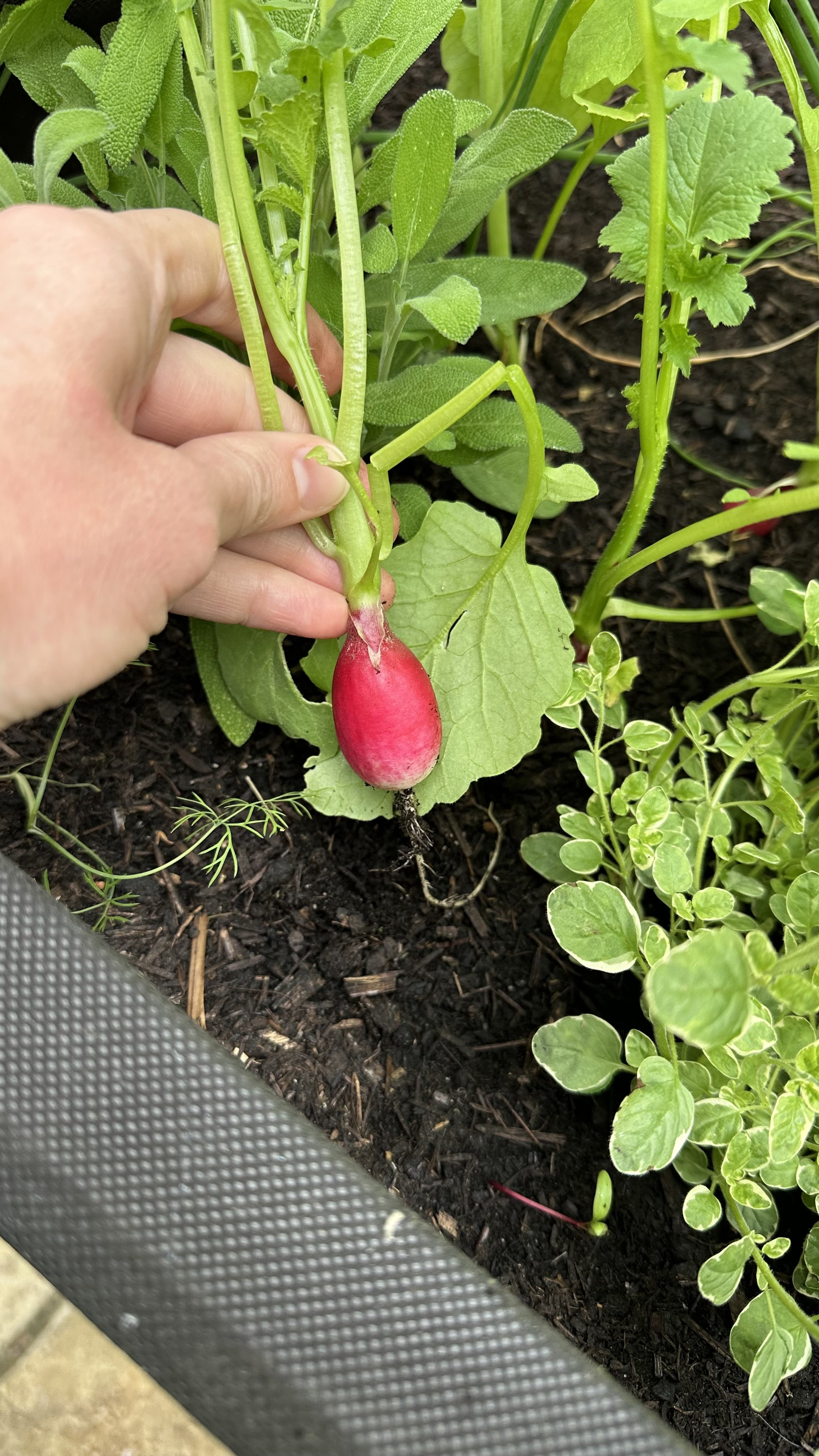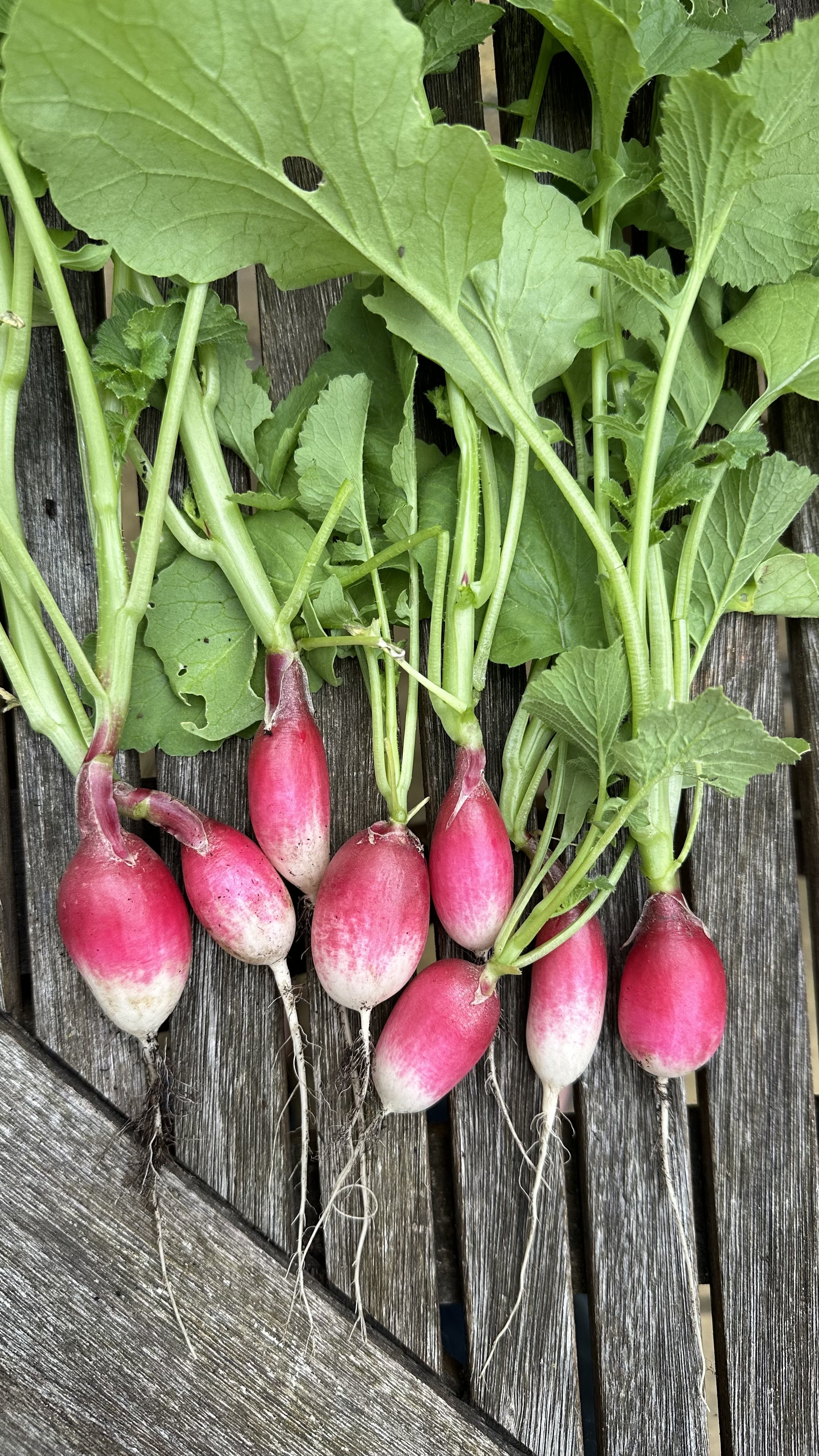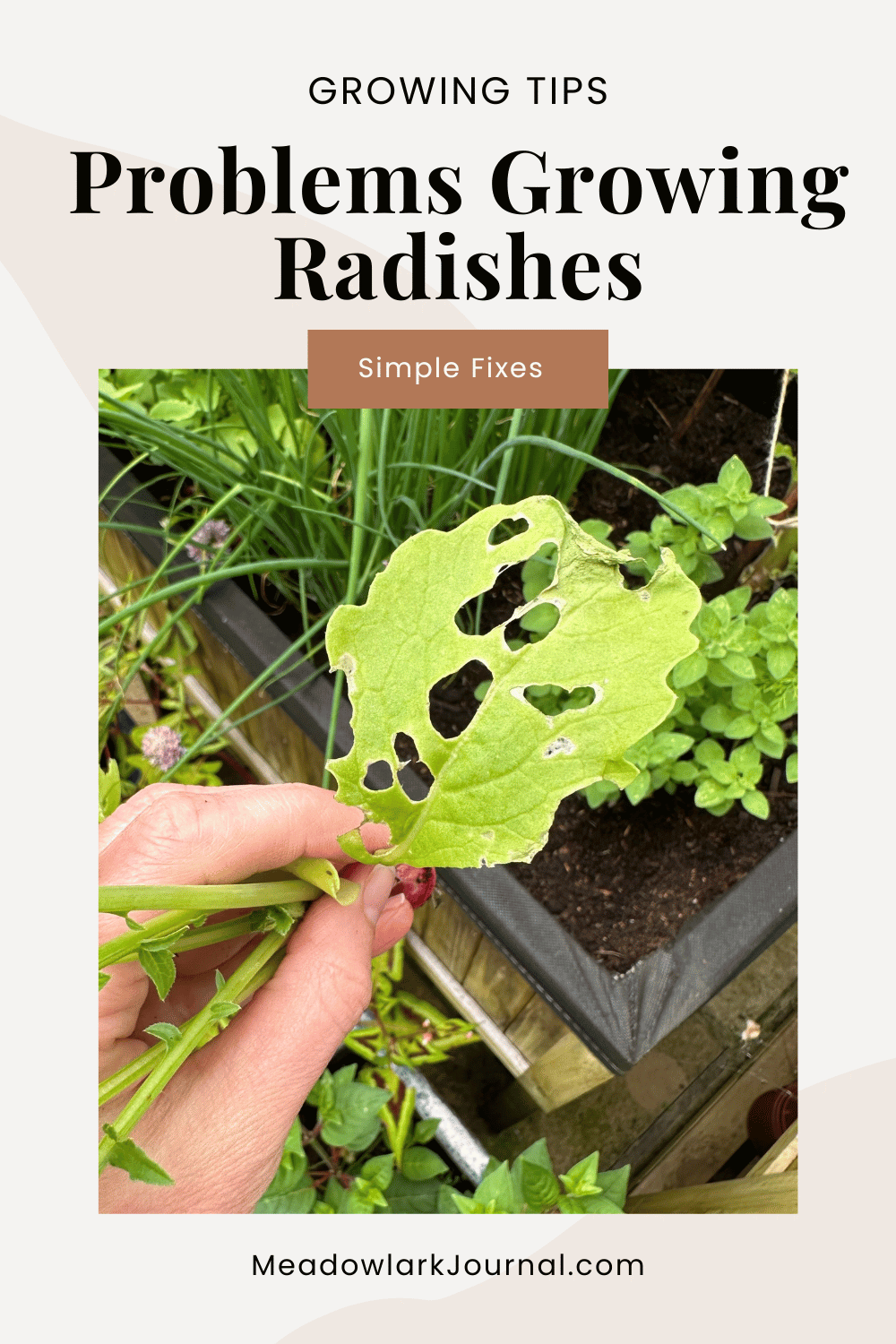Problems Growing Radishes and How to Fix Them
This website is reader-supported - thank you! This post may contain affiliate links. As an Amazon Associate, I earn from qualifying purchases at no extra cost to you.
Radishes are an easy addition to any vegetable garden, known for their quick growth and peppery flavor, and one of my favorite things to interplant amongst vegetables or herbs that take longer to grow.
However, it is easy to experience some problems growing radishes.
From radishes growing above ground to issues with pests and diseases, these radish growing problems can be frustrating.
This gardening guide aims to address the most common issues and provide practical solutions to help you enjoy a successful radish harvest.
To learn more about growing radishes, check out my guide:
Common Problems Growing Radishes
Growing radishes can be straightforward, but certain issues can arise that might hinder their development.
Here are some of the most common problems you can face and tips on how to address them.
Radishes Not Growing
One of the most common issues is radishes failing to grow properly.
This can be due to:
Soil Quality:
Radishes thrive in loose, well-draining soil rich in organic matter.
Poor soil quality can stunt their growth.
Before planting, amend your soil with compost to improve its texture and nutrient content.
Check out my guide: The Best Compost for Vegetable Gardens.
Sunlight:
Radishes require at least 6 hours of direct sunlight per day.
Planting them in a shaded area can result in weak, spindly plants.
Ensure they are positioned in a sunny spot in your garden, like a south-facing or south-west facing spot.
Watering:
Radishes need consistent moisture, but overwatering can lead to root rot.
Water regularly, keeping the soil evenly moist but not waterlogged.
Mulching can help retain moisture and prevent the soil from drying out too quickly.
Check out my guide: The Best Alternatives to Traditional Mulch for Your Garden.
A radish that is all tops and no bottoms.
Radishes All Tops and No Bottoms
This problem occurs when radish plants produce abundant foliage but fail to form bulbs.
The main causes are:
Excess Nitrogen:
High nitrogen levels in the soil encourage leafy growth at the expense of root development.
Use a balanced fertilizer or one lower in nitrogen to promote bulb formation.
Avoid fresh manure, which is high in nitrogen.
Here is the fertilizer I recommend using:
Improper Thinning:
Overcrowded radish plants compete for nutrients, resulting in poor bulb formation.
Thin seedlings to about 2 inches apart to give each plant enough space to grow.
Long and Thin Radishes
Radishes that grow long and thin instead of forming round bulbs often result from:
Overcrowding:
Plants need sufficient space to develop properly.
Thin seedlings early, ensuring they are at least 2 inches apart.
Compacted Soil:
Hard, compacted soil can restrict root development.
Work the soil to a depth of at least 6 inches before planting and add organic matter to improve soil structure.
Radishes Growing Above Ground
When radish bulbs grow above the soil surface, it can indicate:
Shallow Planting:
Radish seeds should be planted about half an inch deep.
Shallow planting can cause the bulbs to push up out of the soil.
Compacted Soil:
Ensure the soil is loose and well-tilled to allow roots to grow downward.
Hard soil can force radish bulbs to grow upwards.
Radishes Splitting
Splitting is a common issue where radish roots crack open.
It is typically caused by:
Inconsistent Watering:
Irregular watering patterns, where the soil alternates between dry and overly wet, can cause the radishes to split.
Maintain consistent moisture levels in the soil.
For more watering tips, check out my guide: How to Use Watering Globes.
Over-Mature Radishes:
Harvest radishes promptly.
Leaving them in the ground too long after they mature can cause them to split.
For more tips, check out my guides:
Pests and Diseases
Radishes can be affected by various pests and diseases.
Understanding these threats and knowing how to manage them is crucial for a successful radish harvest.
Here are some common pests and diseases that can impact radishes and how to deal with them.
Fungal Diseases
Fungal diseases can significantly affect radish plants, leading to poor growth and reduced yields.
Some of the common fungal diseases include:
Damping-Off:
This disease affects seedlings, causing them to rot at the soil line and collapse.
It is often caused by overly wet conditions and poor air circulation.
Check out my guide: How Often to Water Seedlings.
To prevent damping-off, ensure your soil is well-draining, avoid overwatering, and provide good air circulation around the plants.
Using sterilized seed starting mix can also help reduce the risk.
Here is the seed mix I recommend:
Downy Mildew:
Downy mildew appears as yellow patches on the leaves, which later turn brown and dry out.
This disease thrives in cool, moist conditions.
To control downy mildew, water plants at the base to keep foliage dry, avoid overcrowding, and ensure good air circulation.
White Rust:
This disease causes white, blister-like spots on the undersides of leaves.
It can stunt plant growth and reduce yields.
Rotate crops and avoid planting radishes in the same spot each year to prevent white rust.
Remove and destroy affected plants to limit the spread.
Flea Beetles
Flea beetles are tiny, jumping insects that chew small holes in radish leaves, giving them a "shot-hole" appearance.
Severe infestations can stunt plant growth and reduce yields.
Prevention and Control:
Covering young plants with floating row covers can prevent flea beetles from reaching them.
Encourage beneficial insects like ladybugs and lacewings, which prey on flea beetles.
If infestations are severe, you can use insecticidal soaps or neem oil to control the population.
Additionally, planting trap crops like mustard greens can draw flea beetles away from your radishes.
Here is the insecticidal soap I recommend using:
Aphids
Aphids are small, soft-bodied insects that suck the sap from radish leaves, causing them to curl and yellow.
They can also transmit plant diseases.
Prevention and Control:
Introduce beneficial insects like ladybugs and parasitic wasps that prey on aphids by using companion planting.
You can also use insecticidal soaps or neem oil to control aphid populations.
Regularly inspect your plants and remove any aphids by hand or with a strong jet of water.
Root Maggots
Root maggots are the larvae of certain fly species that tunnel into radish roots, causing them to become misshapen and prone to rot.
Prevention and Control:
Use floating row covers to prevent adult flies from laying eggs near your radish plants.
Crop rotation and avoiding planting radishes in the same spot each year can also help reduce root maggot problems.
If you find affected plants, remove and destroy them to prevent the maggots from spreading.
Here are the floating row cover I recommend:
Clubroot
Clubroot is a soil-borne disease that causes radish roots to become swollen and distorted.
It is caused by a pathogen that thrives in acidic soil.
Prevention and Control:
Maintain a soil pH between 6.5 and 7.0 to reduce the risk of clubroot.
Practice crop rotation and avoid planting radishes in areas where clubroot has been a problem.
If you detect clubroot, remove and destroy affected plants and avoid composting them.
To test your soil pH, here is the tester I recommend:
Radishes Bolting
Bolting is when radishes flower and go to seed prematurely.
This often happens due to high temperatures or stress.
Prevention and Control:
Plant radishes in early spring or fall when temperatures are cooler to avoid bolting.
Choose bolt-resistant varieties if your area experiences hot weather.
Ensure plants receive consistent moisture and avoid stressing them with irregular watering.
Here is a great variety that is bold-resistant:
For more tips, check out my guides:
Growing Radishes in Different Conditions
Radishes are versatile and can be grown in various conditions.
However, different growing conditions require specific care techniques to ensure a healthy crop.
Here’s a guide to growing radishes in different environments:
Growing Radishes in Pots
Growing radishes in pots is ideal for gardeners with limited space or those who prefer container gardening.
Here are some tips for successful pot-grown radishes:
Choosing the Right Container:
Use a pot that is at least 6 inches deep to allow enough space for the radish roots to develop.
Here are the containers that I recommend:
Soil Requirements:
Fill the pot with a loose, well-draining potting mix rich in organic matter.
Here is the potting mix I recommend:
Planting Seeds:
Sow radish seeds about half an inch deep and space them according to the variety’s requirements, usually about 1 to 2 inches apart.
Thin seedlings if they become too crowded.
These are some of my favorite radishes to grow:
Sunlight:
Place the pot in a location that receives at least 6 hours of direct sunlight daily.
Radishes need plenty of light to grow well.
Watering:
Keep the soil consistently moist but not waterlogged.
Containers can dry out more quickly than garden beds, so check the moisture level regularly and water as needed.
This is a great way to use rainwater collected from a water butt.
Growing Radishes in the Fall
Fall is an excellent time to grow radishes, especially in regions where summers are too hot for this cool-season crop.
Here’s how to grow radishes successfully in the fall:
Timing:
Plant radish seeds in late summer to early fall, allowing enough time for the plants to mature before the first frost.
Radishes typically take 3 to 4 weeks to mature.
Soil Preparation:
Prepare the soil by adding compost or other organic matter to improve fertility and drainage.
Fall radishes benefit from rich, well-draining soil.
Sunlight and Temperature:
Radishes prefer cooler temperatures and should be planted in a location that receives full sun to partial shade.
Fall radishes often have fewer pest problems and a sweeter flavor due to the cooler weather.
Watering:
Keep the soil evenly moist to ensure rapid growth.
Mulching can help retain moisture and moderate soil temperature.
Problems Growing Radishes in Pots
While growing radishes in pots is convenient, it comes with its own set of challenges:
Overcrowding:
Limited space in pots can lead to overcrowding if not thinned properly.
Ensure adequate spacing between plants to prevent competition for nutrients and light.
Water Management:
Containers can dry out quickly, leading to inconsistent moisture levels.
Regularly monitor the soil moisture and water as needed to keep it consistently moist.
Nutrient Deficiency:
Potted plants can deplete soil nutrients faster than those in garden beds.
Use a balanced, water-soluble fertilizer to provide essential nutrients throughout the growing season.
Problems Growing Radishes in the Fall
Growing radishes in the fall can also present challenges:
Pest Pressure:
While fall typically has fewer pests, be vigilant for late-season pests like aphids and caterpillars.
Use row covers or organic insecticides if necessary.
Frost Protection:
In regions with early frosts, protect your radishes with row covers or cloches.
Radishes are frost-tolerant but young plants can be sensitive to sudden temperature drops.
Timing:
Planting too late in the season can result in radishes not maturing before the first frost.
Check your local frost dates and plan your planting accordingly.
For more tips, check out my guides:
Tips for Healthy Radishes
Ensuring the health and productivity of your radish plants involves more than just addressing common problems and pest issues.
Here are some additional tips to help you grow vibrant and healthy radishes.
Soil Preparation
Loose, Well-Draining Soil:
Radishes prefer loose, well-draining soil.
Compacted soil can hinder root development, leading to poorly formed radishes.
Before planting, work the soil with a spade to a depth of at least 6 inches and incorporate organic matter like compost to improve its structure and drainage.
Proper pH Levels:
Radishes thrive in soil with a pH between 6.0 and 7.0.
Test your soil’s pH and amend it if necessary.
Lime can be added to raise the pH, while sulfur can lower it.
Here is the soil pH tester I recommend:
Thinning
Spacing:
Proper spacing is crucial for radish development.
Thin seedlings to about 2 inches apart once they have a couple of true leaves.
This spacing ensures each plant has enough room to grow without competing for nutrients, light, and water.
Gentle Thinning:
When thinning, be gentle to avoid disturbing the roots of the remaining plants.
Use scissors to snip off unwanted seedlings at the soil line rather than pulling them out.
Consistent Watering
Moisture Levels:
Radishes need consistent moisture to grow evenly.
Irregular watering can lead to splitting or pithy radishes.
Water regularly to keep the soil evenly moist, but avoid waterlogging.
Using a soaker hose or drip irrigation system can help maintain consistent moisture levels.
Here is the soaker hose I recommend:
Mulching:
Apply a layer of mulch around your radish plants to help retain soil moisture, suppress weeds, and regulate soil temperature.
Organic mulches like straw or grass clippings work well.
Fertilization
Balanced Fertilizer:
Radishes benefit from a balanced fertilizer low in nitrogen but rich in phosphorus and potassium.
High nitrogen levels promote leafy growth at the expense of root development.
Apply a balanced fertilizer or compost at planting time and side-dress with a little more if growth appears slow.
Here is the fertilizer I recommend:
Organic Matter:
Incorporating organic matter such as compost or well-rotted manure into the soil before planting can provide essential nutrients and improve soil structure.
Check out my guide: A Simple Recipe for Rich Compost Tea.
Pest and Disease Management
Crop Rotation:
Practice crop rotation to reduce the buildup of soil-borne diseases and pests.
Avoid planting radishes in the same spot where other brassicas (like cabbage or broccoli) were grown in the previous year.
Clean Garden:
Keep your garden clean and free of debris to reduce hiding places for pests.
Remove any diseased or infested plants promptly to prevent the spread of problems.
Companion Planting:
Plant radishes alongside herbs and flowers that repel pests or attract beneficial insects.
For example, nasturtiums can deter many common garden pests, while attracting pollinators and predatory insects.
Check out my guide: Herbs That Can Be Planted Together: The Best Combinations.
Harvesting
Timely Harvest:
Harvest radishes promptly when they reach maturity, usually 3 to 4 weeks after planting.
Leaving them in the ground too long can result in woody, pithy, or split roots.
Check the seed packet for specific maturity dates and monitor the size of the roots by gently brushing away the soil at the base.
Storage:
After harvesting, cut off the tops to prevent moisture loss and store radishes in the refrigerator.
They can be kept fresh in a plastic bag or wrapped in a damp paper towel for up to two weeks.
Succession Planting:
To enjoy a continuous harvest, practice succession planting by sowing radish seeds every two weeks during the growing season.
This approach ensures you have fresh radishes throughout the spring and fall.
Learn more with my guide: What is Succession Planting? Grow More in Less Space.
Quick FAQs
How do I grow radishes from seed?
Plant radish seeds directly in the ground about half an inch deep and 2 inches apart.
Ensure the soil is well-draining and rich in organic matter.
Water consistently and thin seedlings to avoid overcrowding.
Why are my radishes not bulbing?
If your radishes are not forming bulbs, it could be due to overcrowding, poor soil conditions, or insufficient sunlight.
Thin your seedlings, improve soil quality, and ensure they get at least 6 hours of sunlight daily.
What are common radish pests and diseases?
Common pests include flea beetles and aphids, while diseases can include fungal infections like damping-off and downy mildew.
Use row covers, practice crop rotation, and encourage beneficial insects to manage these issues.
How can I prevent my radishes from bolting?
To prevent bolting, plant radishes in early spring or fall when temperatures are cooler.
Avoid planting too late in the season and choose bolt-resistant varieties.
Do radish seeds need light to germinate?
No, radish seeds do not need light to germinate.
Plant them about half an inch deep in soil and keep the soil moist until germination occurs.
How do I know when my radishes are ready to harvest?
Radishes are typically ready to harvest in about 3 to 4 weeks after planting.
The tops of the radishes should be about an inch in diameter. Gently pull one to check its size before harvesting the rest.
How much sun do radishes need?
Radishes need at least 6 hours of sunlight daily to grow properly. Ensure they are planted in a sunny spot in your garden.
Pin this post to save it for later!
